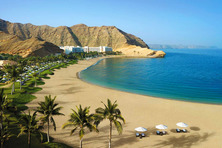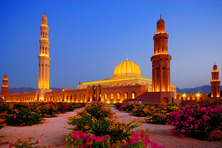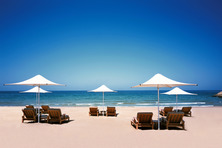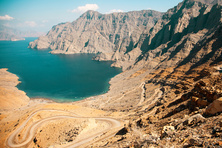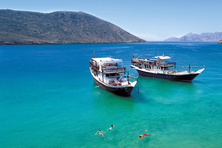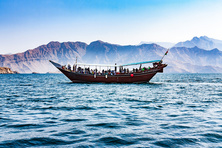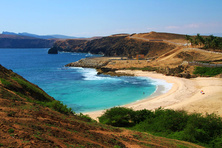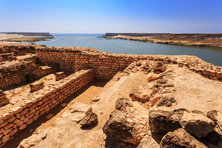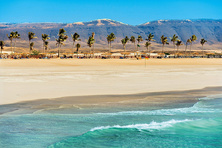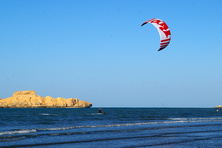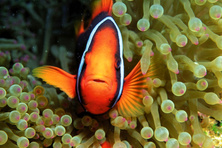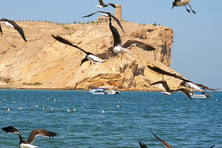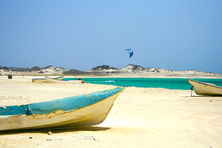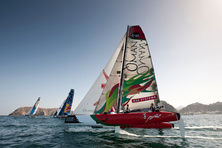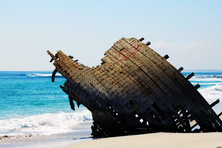Oman
- Currency: Omani rial
- Time: UTC+4
- Languages: Arabic
- Religions: Islam (Ibadi, Sunni)
- Sections: Get in Visa Customs Cuisine Money Details of interest Popular resorts
Oman is a Muslim state on the Arabian peninsula. It shares its borders with Saudi Arabia, the United Arab Emirates, and Yemen. The country is washed by the Arabian Sea, the Gulf of Oman, and the Strait of Hormuz. The capital city is Muscat.
The climate in Oman is tropical and subtropical depending on the region. We recommend coming to Oman from September to April when the heat is not that exhausting.
The official religion is Islam. People speak Arabic.
Those who love city entertainments, sightseeing and tourist attraction should visit Ed-Dakhil and the city of Muscat with its magnificent Sultan Qaboos Grand Mosque. The markets of Sohar and Ibra offer good shopping. The fans of diving and snorkelling usually choose Sur and Al Sawadi.
If you plan to spend your holidays out-of-town and enjoy the nature in the reserves and national parks in Oman, you should head straight to the Masirah Island and Sur.
Are you striving for adventurous holidays? Then you should definitely visit the city of Salalah where camel racing takes place. In Khasab, boat trips are arranged for the tourists during which they can see the birds living on the rocks or watch the dolphins.
Get in
CIS and European tourists should choose a flight to get to Oman.
By Plane
The most convenient route to get to Oman is a transit flight with a transfer in Dubai. For the Russians, it is the most comfortable and short route. It will take about 6 hours. There are also the flights with a stop in Qatar and Turkey.
By Sea
The cruise ships arrive at the ports of Oman and the tourists can choose this way of travelling to the country.
Visa
The CIS and EU tourists can get a visa at the Embassy or on arrival.
We recommend obtaining a visa beforehand for all women who travel to Oman alone as they can be denied a visa.
If you stop in Oman as a transit tourists you still have to get a visa.
Customs
The Customs legislation of Oman does not restrict the import and the export of local and foreign currency. It is prohibited to pass the border with the currency of Israel.
Duty-free import extends to alcohol, tobacco, and perfume. However, the tourists should learn about the limits.
The tourists are allowed to bring in DVDs (8 pieces maximum) for personal use, but the video material must not threaten the principles of Islam.
To import medications, a prescription is required.
It is prohibited import:
- bees;
- coconuts, dates and palm fruits;
- non-canned food.
Imported meat products must be prepared according to the Muslim traditions.
The export of any items with historical, archaeological, and cultural values is prohibited.
If you buy antiquities, ask for a sale receipt confirming that you bought them. If you bought cold steel in a souvenir shop, you must include it in your checked-in baggage.
Cuisine
The traditional cuisine of Oman is quite simple. The climate of the country does not allow growing many vegetables and the most common side dish here is lentils, rice, and pea beans. Gravies are popular in Oman. The tourists should try the Omani bread Khubz.
The tourists are offered Mishkak type of (BBQ), Ljakhm Nashif (a meat stew with onions, tomatoes, and spices), and a famous Omani dish Shuwa (mutton roasted in an underground pit covered with herbs).
The foodies will probably be disappointed about the dishes from poultry. Despite the generous use of herbs and spices, there are not varieties of poultry dishes. The tourists can try roasted chicken, baked chicken, and a chicken stew with lentils or peas.
But there is a great variety of seafood in Oman. Prawns, squids, crawfish, and oysters with spices and herbs will reveal new tastes for you. We recommend Samak Meschoui (a fish and vegetables stew with pea beans) and exotic shark meat. Those who cannot imagine their life without sweets can try juicy fruits, dates, and traditional Omani Khalvah.
Coffee gained a special love among the locals. They make it with cardamom and Rose water. Tea is the second popular drink in Oman. They prefer tea with mint and milk. It quenches the thirst very well.
Alcoholic drinks are not approved here, however, the tourists will find a great choice of wines, beer and strong alcoholic drinks in hotels and in restaurants.
Money
The Oman Rial is the national currency. In circulation are:
- 1 to 100 baisa coins (1 rial = 1.000 baisas);
- banknotes from 0.1 to 50 rials.
The tourists can exchange the currency at banks and in exchange offices in large cities. But be aware that Friday in Oman is a day off.
You should pay for the goods in rials. On the markets, you can try and agree with the seller to pay with US dollars or Euros, but we do not think you will like the rate.
Credit cards are accepted in hotels, large malls, and restaurants.
There are ATMs in Oman but not all ATMs accept the cards issued by foreign banks.
The tourists can cash traveller’s checks at banks and in large hotels.
Details of interest
Oman is a Muslim country. Although the citizens of Oman cordially welcome the foreigners, the tourists should respect the principles of Islam.
During cultural events, the tourists can learn more about the country. An outstanding even in Oman is the Muscat festival, which takes place in February. This is the largest festival in the countries of the Arabia Gulf. The tourists will see circus, musical and ethnographic performances.
Sightseeing in Oman
On the territory of the country, there are four monuments inscribed on the UNESCO World Heritage List. They are the Bahla Fort, the Frankincense trail, the Afladzh Irrigation systems, and the Archaeological Sites of Bat, Al-Khutm and Al-Ayn.
- The Bahla Fort was erected in the 13th century and was surrounded by the wall. Its total length is 12 kilometres.
- The Archaeological Sites of Bat, Al-Khutm and Al-Ayn formed a complex of necropolis and settlements (the 3d century B.C.). The complex is considered to be the most complete and better preserved among the other ancient monuments of civilisations.
- The Frankincense trail is one of the most ancient trading routes which extends between the caravan oasis and the ports Al balid and Khor Rori. Its significance is similar to the Silk Road.
- The Afladzh Irrigation systems are the five oldest irrigations systems in Oman. They include the houses, sun clock, mosques, and the building where a water auction took place. Afladzh was built in 2.500 B.C. and is believed to be one of the best environmental management systems of the ancient world.
- The Sultan Qaboos Grand Mosque in Muscat. It is the largest Mosque in the Arab countries.
- Wadi Dawkah River is the largest full-flowing river on the whole Arabian peninsula.
- The Cave Majlis Al-Jin is among the largest caves in the world.
- The Harrapan inscriptions in Ras al-Jinz are the oldest examples of writings on the Peninsula.
Souvenirs in Oman
The tourists can visit the markets in Muscat, Sur, and other cities. There they can buy essential oils, fragrances, and delicate sandal wood crafts.
In the city of Salalah, the tourists can buy silver and golden jewellery.
A hallmark of Oman is unique knives Khanjars. The knives are often not only a souvenir, but a valuable antiquity. The knives that were made in the century before last can cost several thousand dollars.
In Oman, the most expensive perfume Amouage is produced. Women will be able to evaluate this French and Omani masterpiece.
Natural coffee is a good gift for friends and family. Buy coffee in supermarkets and in a vacuum packing to make sure the product is fresh.







